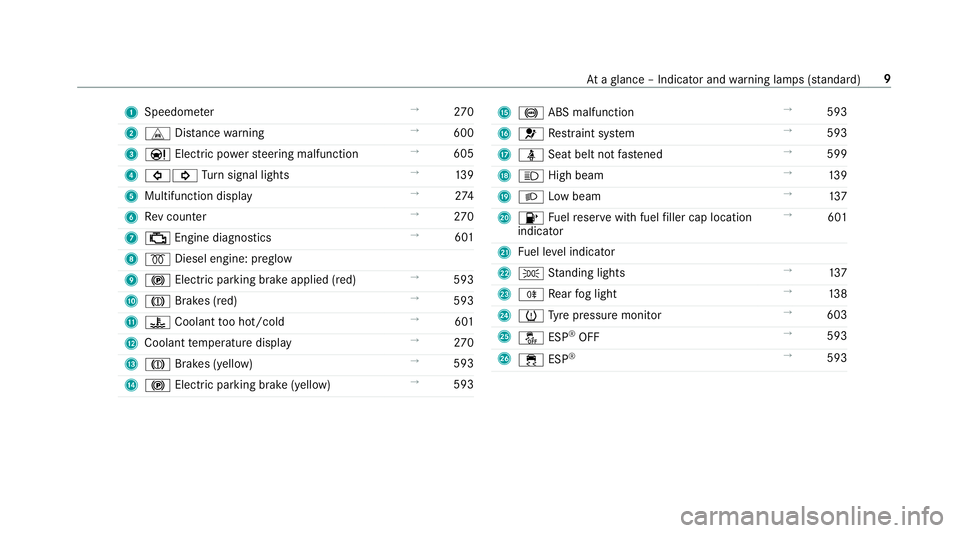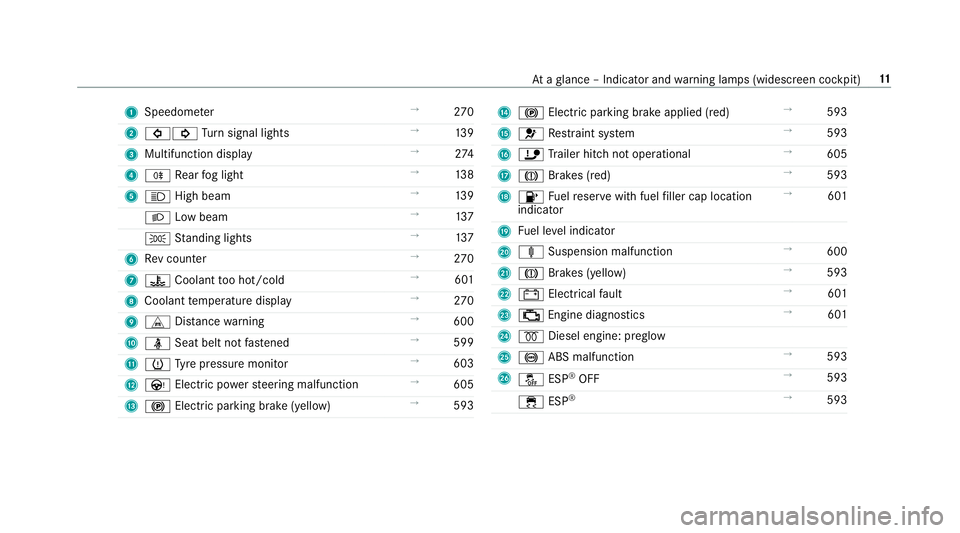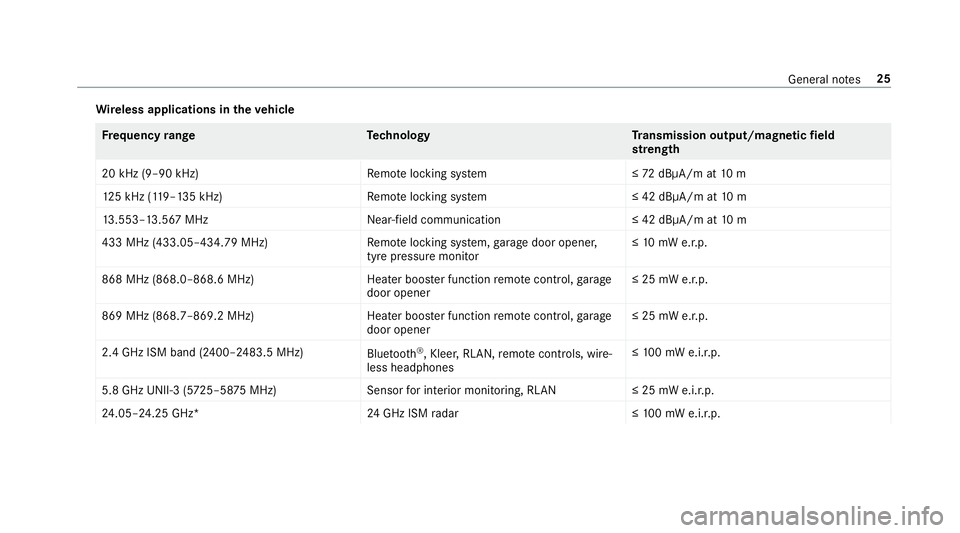2019 MERCEDES-BENZ GLC COUPE tyre pressure
[x] Cancel search: tyre pressurePage 6 of 657

Climate control
........................................ 15 3
Overview of climate contro l systems ..........1 53
Operating the climate control sy stem ......... 154 Driving and pa
rking ................................. 16 5
Driving ........................................................ 16 5
DY NA MIC SELECT switch ............................1 77
Au tomatic transmission .............................. 17 9
Fu nction of the 4MATIC .............................. 184
Re fuelling .................................................... 184
Pa rking ...................................................... .190
Driving and driving saf ety sy stems .............1 99
Tr ailer hit ch................................................ 262
Bicycle rack function .................................. 267
Ve hicle towing instructions ........................ .269 Instrument Display and on-board
comp uter.................................................. 270
Instrument display overview ...................... .270
Overview of the buttons on thesteering
wheel ..........................................................2 71
Operating the on-board computer .............. 272
Setting the design ....................................... 273
Setting the area for additional values .......... 274Overview of displa
yson the multifunc‐
tion display .................................................2 74
Ad justing the instrument lighting ................2 75
Menus and submenus ................................. 275
Head-up Display ......................................... 282 LI
NG UATRONIC ........................................ 284
No tes on operating saf ety .......................... 284
Ope ration ................................................... 285
Using LINGU ATRO NIC ef fectively ................ 287
Essential voice commands ........................ .288 MBUX multimedia sy
stem ...................... 304
Overview and operation .............................. 304
Sy stem settings .......................................... 340
Fit & Healt hy............................................... 349
Na vigation .................................................. 354
Te lephone .................................................. .397
Online and Internet functions ..................... 428
Media ......................................................... 437
Ra dio .......................................................... 445
TV ............................................................... 448
Sound ......................................................... 456 Main
tenance and care ............................. 460
ASS YST PLUS service inter val display ........ 460
Engine compartment .................................. 461
Cleaning and care ...................................... .469 Breakdown assi
stance ............................ 47 9
Emergency ................................................. .479
Flat tyre ...................................................... 481
Battery (vehicle) ......................................... 487
To w- starting or towing away ....................... 493
Electrical fuses ........................................... 498 Wheels and tyres
..................................... 502
No tes on noise or unusual handling char‐
acteristics .................................................. .502
No tes on regular lyinspecting wheels and
tyres .......................................................... .502
No tes on snow chains ................................ 502
Ty re pressure .............................................. 503
Wheel change .............................................. 511
Emergency spare wheel .............................. 520 Contents
3
Page 12 of 657

1
Speedom eter →
270
2 L Distance warning →
600
3 Ð Electric po werst eering malfunction →
605
4 #! Turn signal lights →
13 9
5 Multifunction display →
274
6 Rev counter →
270
7 ; Engine diagnostics →
601
8 % Diesel engine: preglow
9 ! Electric pa rking brake applied (red) →
593
A J Brakes (red) →
593
B ? Coolant too hot/cold →
601
C Coolant temp erature display →
270
D J Brakes (yell ow) →
593
E ! Electric parking brake (yell ow)→
593 F
! ABS malfunction →
593
G 6 Restra int sy stem →
593
H ü Seat belt not fastened →
599
I K High beam →
13 9
J L Low beam →
137
K 8 Fuelreser vewith fuel filler cap location
indicator →
601
L Fuel le vel indicator
M T Standing lights →
137
N R Rear fog light →
13 8
O h Tyre pressure monitor →
603
P å ESP®
OFF →
593
Q ÷ ESP®
→
593 At
aglance – Indicator and warning lamps (s tanda rd) 9
Page 14 of 657

1
Speedom eter →
270
2 #! Turn signal lights →
13 9
3 Multifunction display →
274
4 R Rear fog light →
13 8
5 K High beam →
13 9
L Low beam →
137
T Standing lights →
137
6 Rev counter →
270
7 ? Coolant too hot/cold →
601
8 Coolant temp erature display →
270
9 L Distance warning →
600
A ü Seat belt not fastened →
599
B h Tyre pressure monitor →
603
C Ù Electric po werst eering malfunction →
605
D ! Electric pa rking brake (yellow) →
593 E
! Electric parking brake applied (red) →
593
F 6 Restra int sy stem →
593
G ï Trailer hit chnot operational →
605
H J Brakes (red) →
593
I 8 Fuelreser vewith fuel filler cap location
indicator →
601
J Fuel le vel indicator
K ä Suspension malfunction →
600
L J Brakes (yellow) →
593
M # Electrical fault →
601
N ; Engine diagnostics →
601
O % Diesel engine: preglow
P ! ABS malfunction →
593
Q å ESP®
OFF →
593
÷ ESP®
→
593 At
aglance – Indicator and warning lamps (widesc reen cockpit) 11
Page 22 of 657

Pr
otection of the environment
Plug-in hybrid: obser vethe no tes in the Supple‐
ment. Otherwise, you may failto recognise dan‐
ge rs.
+ ENVIRONMENTAL
NOTEEnvironmental
dama gedue tooperating conditions and
personal driving style The pollutant emission of
your vehicle is
directly related tothewa yyo u operate your
ve hicle.
Help toprotect the environment byoperating
yo ur vehicle in an environmentally responsi‐
ble manner. Please obser vethefo llowing rec‐
ommendations on ope rating conditions and
pe rsonal driving style.
Operating conditions: #
Make sure that the tyre pressure is cor‐
re ct. #
Do not car ryany unnecessary weight
(e.g. roof luggage rack s once you no
lon ger need them). #
Adhere tothe service inter vals.
A regularly serviced vehicle will contri b‐
ute toenvironmen tal pr otection. #
Alw ays ha vemaintenance workcar ried
out at a qualified specialist workshop.
Pe rsonal driving style: #
Do not depress the accelera tor pedal
when starting the engine. #
Do not warm upthe engine while the
ve hicle is stationar y. #
Drive carefully and maintain a suitable
di st ance from theve hicle in front. #
Avoid frequent, sudden acceleration
and braking. #
Change gear in good time and use each
ge ar on lyup toÔ of its maximum
engine speed. #
Switch off the engine in stationary traf‐
fi c, e.g. byusing the ECO start/ stop
function. #
Drive fuel-ef ficiently. Obser vethe ECO
display for a fuel-ef ficient driving style. +
ENVIRONMEN
TALNO TEEnvironmental
pollution caused byirre sponsible dis‐
posal of the high-voltage battery A high-voltage battery conta
ins materials
which are harmful tothe environment. #
Dispose of faulty high-voltage bat teries
at a qualified specialist workshop. Ta
ke -back of end-of-life vehicles
EU countries onl y:
Mercedes-Benz will take back your end-of-life
ve hicle for environment-friendly disposal in
accordance with the European Union(EU) End-
of-Life Vehicles Directive.
A network of vehicle take -ba ckpoints and dis‐
mantlers has been es tablished foryo uto return
yo ur vehicle. You can lea veit at any of these
points free of charge . This makes an impor tant
contribution toclosing there cycling circle and
conse rving resources.
Fo r fur ther information about there cycling and
disposal of end-of-li fevehicles, and theta ke- Gene
ral no tes 19
Page 28 of 657

Wire
less applications in theve hicle Fr
equency rang eT echnology Transmission output/magn etic field
st re ngth
20 kHz (9–90 kHz)R emotelocking sy stem ≤72 dBμA/m at 10 m
12 5 kHz (1 19–135 kHz)R emotelocking sy stem ≤ 42 dBμA/m at10 m
13 .553–13.567 MHz Near-field communication ≤ 42 dBμA/m at10 m
433 MHz (433.05–434.79 MHz) Remo telocking sy stem, garage door opener,
tyre pressure monitor ≤
10 mW e.r.p.
868 MHz (868.0–868.6 MHz) Heater booster function remo tecontrol, garage
door opener ≤ 25 mW e.r.p.
869 MHz (868.7–869.2 MHz )Heater booster function remo tecontrol, garage
door opener ≤ 25 mW e.r.p.
2.4 GHz ISM band (2400–2483.5 MHz) Bluetooth ®
, Kleer, RLAN, remo tecontrols, wi re‐
less headphones ≤
10 0 mW e.i.r.p.
5.8 GHz UNII-3 (5 725–58 75MHz) Sensorfor interior monitoring, RLAN ≤ 25 mW e.i.r.p.
24 .05–24.25 GHz* 24GHz ISM radar ≤10 0 mW e.i.r.p. Gene
ral no tes 25
Page 33 of 657

Data
storage Electronic control units
Elect
ronic control units are fitted in your vehicle.
Some of these are necessary forth e safe opera‐
tion of your vehicle, while some assist you when
driving (driver assis tance sy stems). In addition,
yo ur vehicle pr ovides com fort and enter tainment
functions, which are also made possible byelec‐
tronic control units.
Elect ronic control units contain da tamemories
which can temp orarily or permanently store
te ch nical information about theve hicle's operat‐
ing state, component loads, main tenance
re qu irements and tech nical events or faults.
In general, this information documents thest ate
of a component part, a module, a sy stem or the
sur roundings such as:
R operating status of sy stem components (e.g.
fi ll le vels, battery status, tyre pressure)
R status messages concerning theve hicle or
its individual components (e.g. number of
wheel revo lutions/speed, longitudinal accel‐ eration, lateral acceleration, display of
fas‐
te ned seat belts)
R malfunctions or faults in impor tant sy stem
components (e.g. lights, brakes)
R information on events leading tovehicle
damage
R system reactions in special driving situations
(e.g. airbag deployment, inter vention of sta‐
bility control sy stems)
R ambient conditions (e.g. temp erature, rain
sensor)
In addition toprov iding the actual control unit
function, this data assists the manufacturer in
de tecting and rectifying faults and optimising
ve hicle functions. The majority of this data is
te mp orary and is only processed in theve hicle
itself. Only a small portion of the data is stored
in theeve nt or fault memor y.
When your vehicle is serviced, tech nical da ta
from theve hicle can be read out byservice net‐
wo rkemplo yees (e.g. workshops, manufactur‐
ers) or third parties (e.g. breakdown services).
Services include repair services, maintenance
processes, warranty claims and quality assur‐ ance measures,
forex ample. The read out is per‐
fo rm ed via the legally prescribed port forthe
diagnostics connection in theve hicle. The
re spective service network locations or third
parties collect, process and use the data. They
document tech nical statuses of theve hicle,
assist in finding faults and impr oving quality and
are transmitted tothe manufacturer, if neces‐
sar y.Fu rthermore, the manufacturer is subject
to product liability. Forth is, the manufacturer
requ irestech nical da tafrom vehicles.
Fa ult memories in theve hicle can be reset by a
service outlet as part of repair or maintenance
wo rk.
Depending on the selected equipment, you can
import data into vehicle con venience and info‐
ta inment functions yourself.
This includes, forex ample:
R multimedia data such as music, films or pho‐
to sfo r playback in an integrated multimedia
sy stem
R address book data for use in connection with
an integrated hands-free sy stem or an inte‐
grated navigation sy stem 30
General no tes
Page 173 of 657

#
open a side window or the sliding sunroof. Ru
nning-in no tes Mercedes-AMG
vehicles: observeth e no tes in
th e Supplement. Otherwise, you may failto rec‐
ognise dangers.
To preser vethe engine during thefirs t1, 500 km:
R drive at varying road speeds and engine
speeds.
R drive theve hicle in drive program A
or ;.
R change gear before there v counter needle is
Ô ofthewa yto there d area of there v coun‐
te r.
R do not shift down a gear manually in order to
brake.
R avoidoverstra ining theve hicle, e.g. driving at
full thro ttle.
R do not depress the accelera tor pedal past
th e pressure point (kickdown). R
only increase the engine speed gradually and
accelerate theve hicle tofull speed af ter
1, 500 km.
This also applies when the engine or parts of the
driv etra in ha vebeen replaced.
Please also obser vethefo llowing running-in
no tes:
R in cer tain driving and driving saf ety sy stems,
th e sensors adjust automatically while a cer‐
ta in dis tance is being driven af terth eve hicle
has been delivered or af terre pairs. Full sys‐
te m ef fectiveness is not reached until the
end of this teach-in process.
R brakepads, brake discs and tyres that are
either new or ha vebeen replaced only ach‐
ie ve optimum braking ef fect and grip af ter
se veral hundred kilom etre s of driving. Com‐
pensate forth ere duced braking ef fect by
applying greaterfo rc eto the brake pedal. Note
s on driving &
WARNING Risk of accident due to
objects in the driver's foot we ll
Objects in the driver's foot we ll may impede
pedal tr avel or block a depressed pedal.
This jeopardises the operating and road
saf ety of theve hicle. #
Stow all objects in theve hicle securely
so that they cannot getinto the driver's
fo ot we ll. #
Alw aysfit th efloor mats securely and
as prescribed in order toensure that
th ere is alw ays suf ficient room forthe
pedals. #
Do not use loose floor mats and do not
place floor mats on top of one ano ther. 17 0
Driving and pa rking
Page 190 of 657

*
NO
TEFuel may spr ayout when you
re mo vethe fuel pump nozzle. #
Only fill th e fuel tank until the pump
nozzle switches off. Re
quirements:
Plug-in-hybrid: forve hicles with a petrol engine,
obser vethe no tes in the Supplement. Otherwise,
yo u may failto recognise dangers.
R The vehicle is unloc ked (/ page75).
% Do not get into theve hicle again during the
re fuelling process. Otherwise, electros tatic
ch arge could build up again.
Obser vethe no tes on operating fluids
(/ page 526). 1
Fuelfiller flap
2 Brac ketfo rth e fuel filler cap
3 Tyre pressure table
4 QR code forre scue card
5 Fuel type #
Press on the back area of fuel filler flap 1. #
Turn the fuel filler cap anti-clockwise and
re mo veit. #
Insert the fuel filler cap into brac ket2. #
Comp lete ly inse rtthe pump nozzle into the
ta nk filler nec k,hook in place and refuel. #
Only fill th e fuel tank until the pump nozzle
switches off.
% Vehicles with a diesel engine: theta nk
fi ller neck is designed forre fuelling at diesel
fi lling pumps.
% Vehicles with a diesel engine: whenthe
fuel tank is compl etely em pty, top up with at
least 5 litres of diesel.
% Vehicles with a diesel engine: use afiller
neck with a lar gediame terfo rve hicles with
a diesel engine when topping up fuel from a
fuel can. Otherwise, thefiller neck cannot
slide into theta nk. #
Replace the cap on thefiller neck and turn
clockwise until it engages audibl y. #
Close fuel filler flap 1. Driving and parking
187